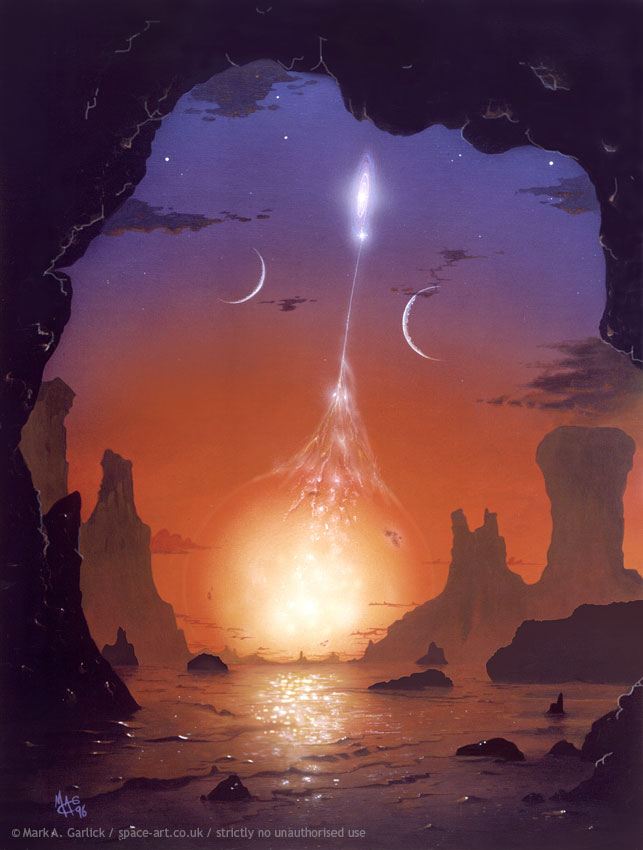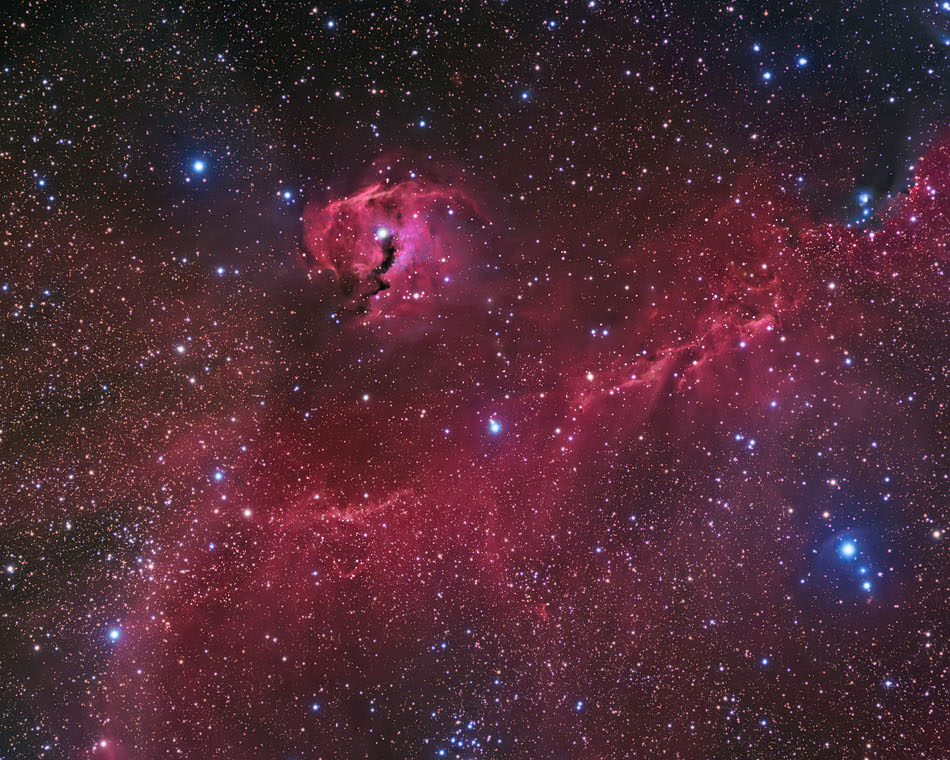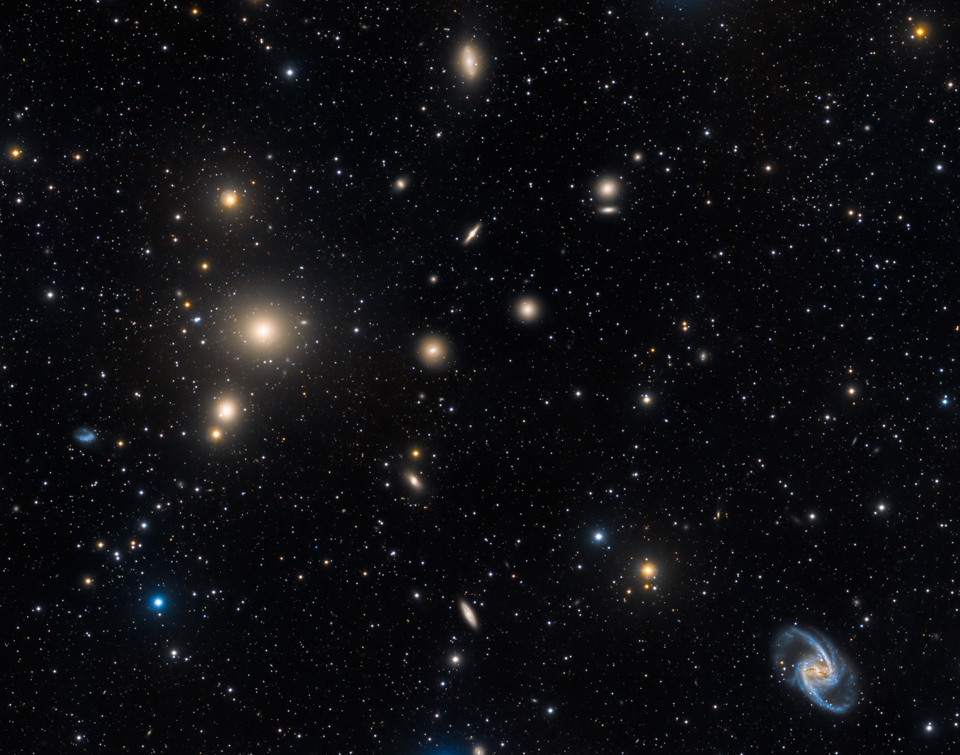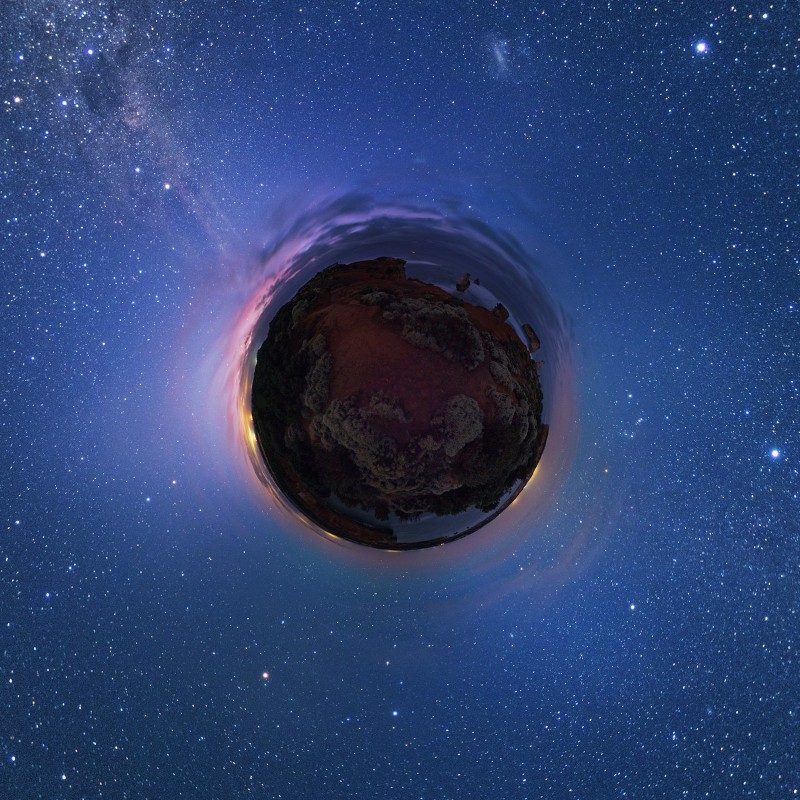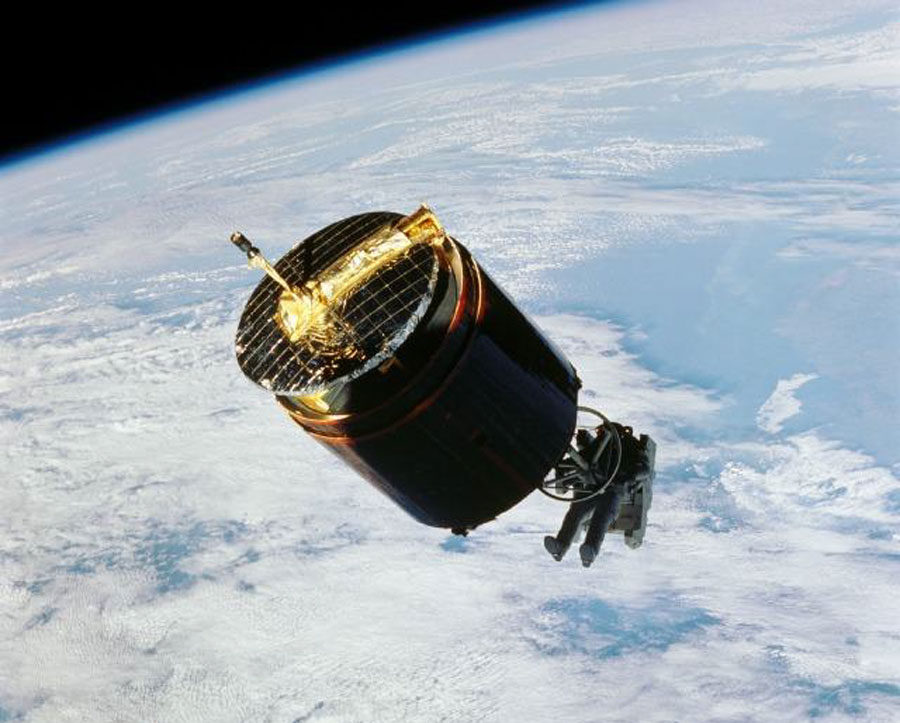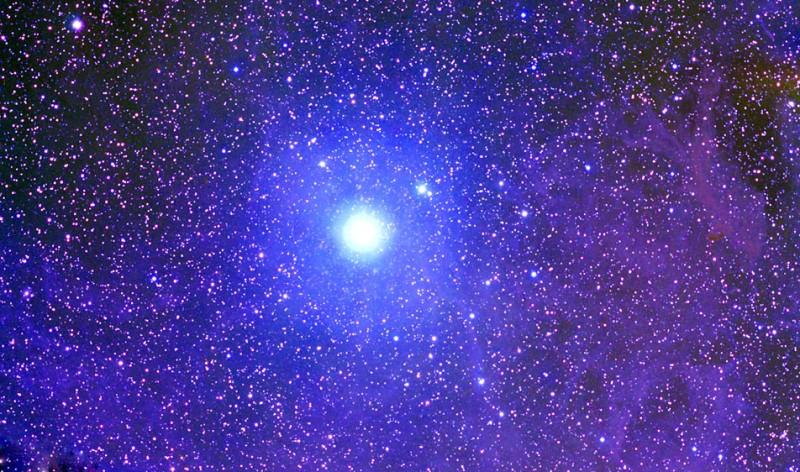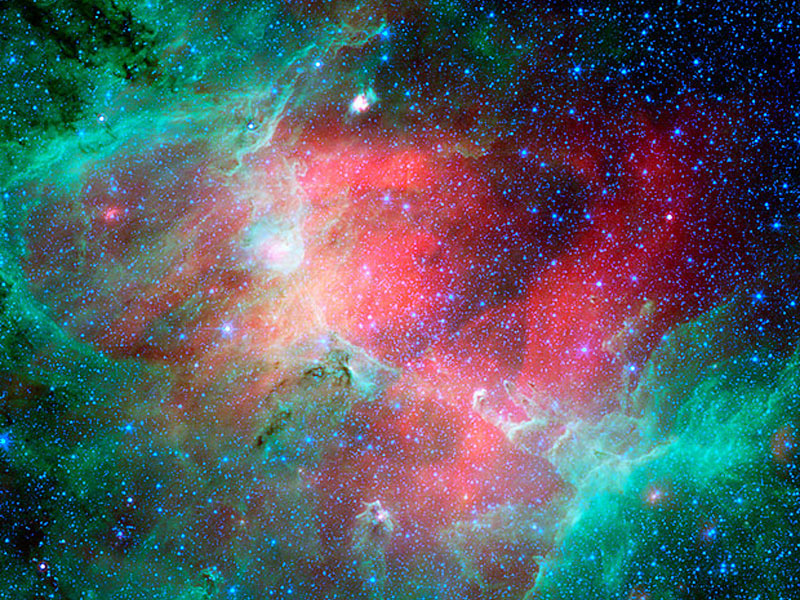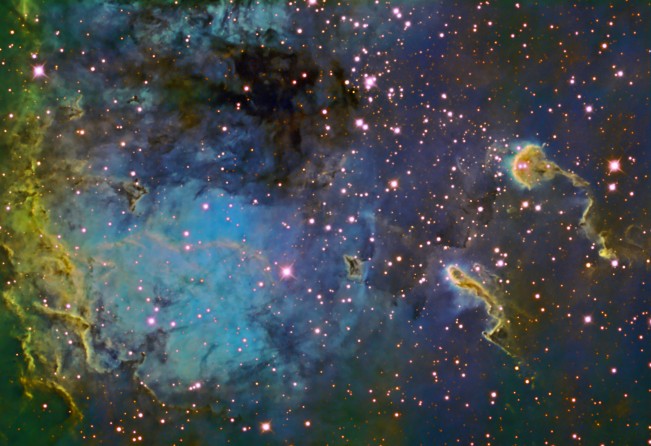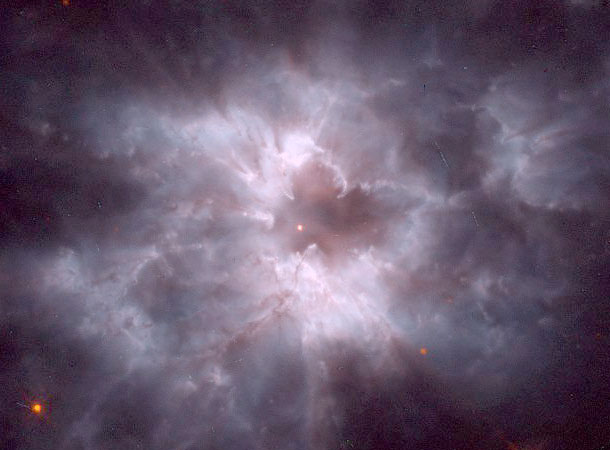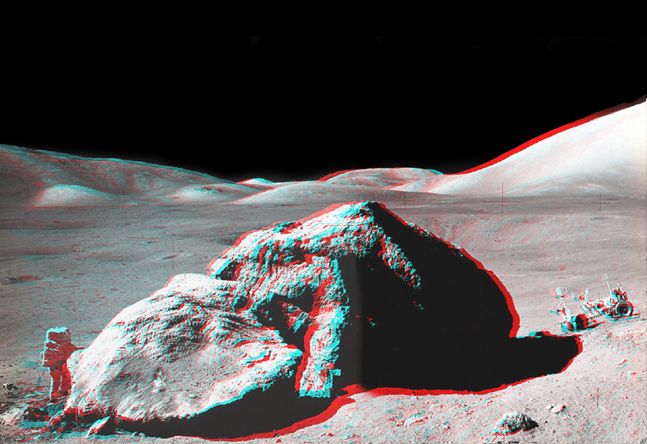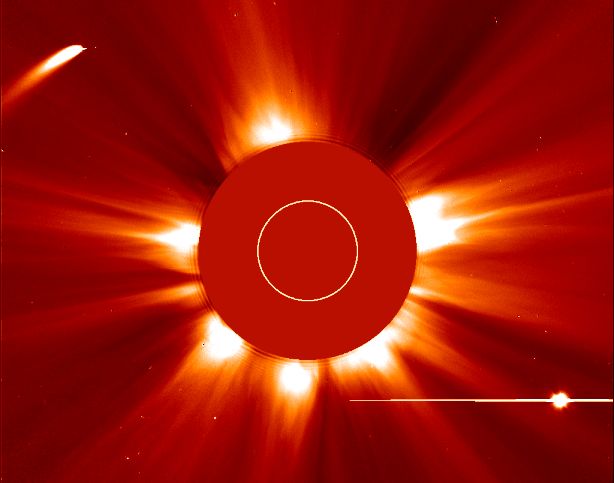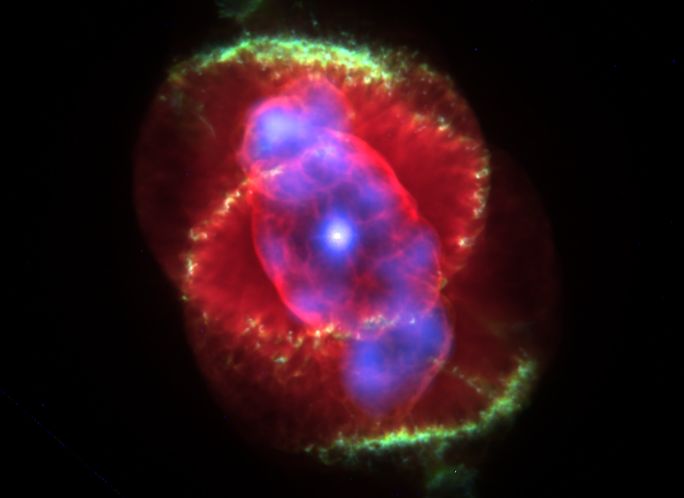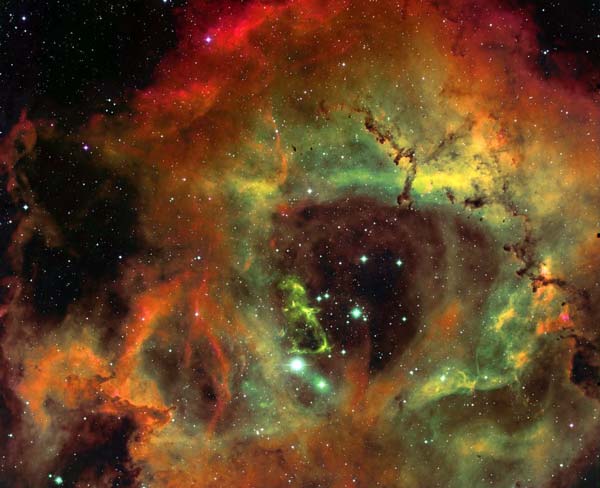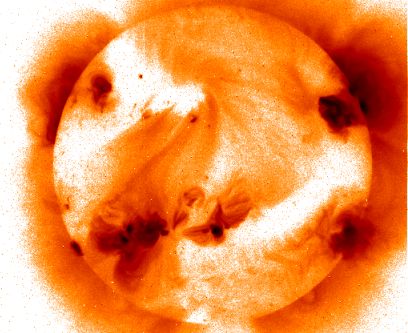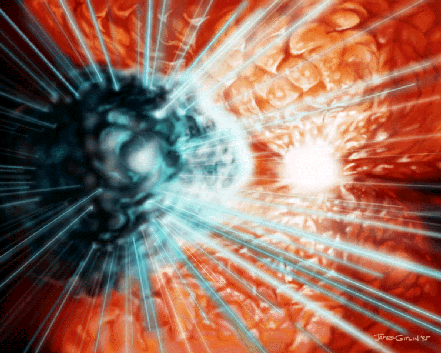APOD Retrospective: January 11
Posted: Wed Jan 11, 2012 4:43 am
| << Previous | Index | Next >> |
2015 Will this dawn bring another nova? Such dilemmas might be pondered one day by future humans living on a planet orbiting a cataclysmic variable binary star system. Cataclysmic variables involve gas falling from a large star onto an accretion disk surrounding a massive but compact white dwarf star. Explosive cataclysmic events such as a dwarf nova can occur when a clump of gas in the interior of the accretion disk heats up past a certain temperature. At that point, the clump will fall more quickly onto the white dwarf and land with a bright flash. Such dwarf novas will not destroy either star, and may occur irregularly on time scales from a few days to tens of years. Although a nova is much less energetic than a supernova, if recurrent novas are not violent enough to expel more gas than is falling in, mass will accumulate onto the white dwarf star until it passes its Chandrasekhar limit. At that point, a foreground cave may provide little protection, as the entire white dwarf star will explode in a tremendous supernova.
2014 A broad expanse of glowing gas and dust presents a bird-like visage to astronomers from planet Earth, suggesting its popular moniker - The Seagull Nebula. This portrait of the cosmic bird covers a 1.6 degree wide swath across the plane of the Milky Way, near the direction of Sirius, alpha star of the constellation Canis Major. Of course, the region includes objects with other catalog designations: notably NGC 2327, a compact, dusty emission region with an embedded massive star that forms the bird's head (aka the Parrot Nebula, above center). Dominated by the reddish glow of atomic hydrogen, the complex of gas and dust clouds with bright young stars spans over 100 light-years at an estimated 3,800 light-year distance.
2013 How do clusters of galaxies form and evolve? To help find out, astronomers continue to study the second closest cluster of galaxies to Earth: the Fornax cluster, named for the southern constellation toward which most of its galaxies can be found. Although almost 20 times more distant than our neighboring Andromeda galaxy, Fornax is only about 10 percent further that the better known and more populated Virgo cluster of galaxies. Fornax has a well-defined central region that contains many galaxies, but is still evolving. It has other galaxy groupings that appear distinct and have yet to merge. Seen here, almost every yellowish splotch on the image is an elliptical galaxy in the Fornax cluster. The picturesque barred spiral galaxy NGC 1365 visible on the lower right is also a prominent Fornax cluster member.
2012 Once a bright apparition in the southern hemisphere dawn Comet Lovejoy is fading, but its long tail still stretches across skies near the south celestial pole. Captured on the morning of December 30th, the comet appears near edge of this little planet as well. Of course, the little planet is actually planet Earth and the image was created from a 12 frame mosaic used to construct a spherical panorama. The type of stereographic projection used to map the image pixels is centered directly below the camera and is known as the little planet projection. Stars surrounding this little planet were above the photographer's cloudy horizon near the Bay of Islands on the Great Ocean Road in southern Victoria, Australia. Running alongside the Milky Way the comet can be identified, with other celestial highlights, by putting your cursor over the picture. Very bright stars Canopus and Sirius are right of the little planet.
2011 It is the largest and most complex star forming region in the entire galactic neighborhood. Located in the Large Magellanic Cloud, a small satellite galaxy orbiting our Milky Way galaxy, the region's spidery appearance is responsible for its popular name, the Tarantula nebula. This tarantula, however, is about 1,000 light-years across. Were it placed at the distance of Milky Way's Orion Nebula, only 1,500 light-years distant and the nearest stellar nursery to Earth, it would appear to cover about 30 degrees (60 full moons) on the sky. Intriguing details of the nebula are visible in the above image shown in scientific colors. The spindly arms of the Tarantula nebula surround NGC 2070, a star cluster that contains some of the brightest, most massive stars known, visible in blue on the right. Since massive stars live fast and die young, it is not so surprising that the cosmic Tarantula also lies near the site of the closest recent supernova.
2010 In 1984, high above the Earth's surface, an astronaut captured a satellite. It was the second satellite captured that mission. Pictured above, astronaut Dale A. Gardner flies free using the Manned Maneuvering Unit and begins to attach a control device dubbed the Stinger to the rotating Westar 6 satellite. Communications satellite Westar 6 had suffered a rocket malfunction that left it unable to reach its intended high geosynchronous orbit. Both the previously caught Palapa B-2 satellite and the Westar 6 satellite were guided into the cargo bay of the Space Shuttle Discovery and returned to Earth. Westar 6 was subsequently refurbished and sold.
2009 In the shadow of Saturn, unexpected wonders appear. The robotic Cassini spacecraft now orbiting Saturn recently drifted in giant planet's shadow for about 12 hours and looked back toward the eclipsed Sun. Cassini saw a view unlike any other. First, the night side of Saturn is seen to be partly lit by light reflected from its own majestic ring system. Next, the rings themselves appear dark when silhouetted against Saturn, but quite bright when viewed away from Saturn, slightly scattering sunlight, in this exaggerated color image. Saturn's rings light up so much that new rings were discovered, although they are hard to see in the image. Seen in spectacular detail, however, is Saturn's E ring, the ring created by the newly discovered ice-fountains of the moon Enceladus and the outermost ring visible above. Far in the distance, at the left, just above the bright main rings, is the almost ignorable pale blue dot of Earth.
2008
2007 In visible light, the whole thing looks like an eagle. The region was captured recently in unprecedented detail in infrared light by the robotic orbiting Spitzer Space Telescope (SSC). Shown above, the infrared image allows observers to peer through normally opaque dust and so better capture the full complexity of the Eagle Nebula star forming region. In particular, the three famous pillars near the image center are seen bathed in dust likely warmed by a supernova explosion. The warm dust is digitally assigned the false color of red. Also visible, near the bottom of the image, is ten light-year long pillar sometimes dubbed the Fairy of Eagle Nebula. The greater Eagle emission nebula, tagged M16, lies about 6500 light years away, spans about 20 light-years, and is visible with binoculars toward the constellation of Serpens.
2006 This close-up view shows a portion of otherwise faint emission nebula IC 410 in striking false-colors. It also shows two remarkable denizens of the glowing gas cloud at the right - the "tadpoles" of IC 410. The picture is a composite of images taken through narrow band filters intended to trace atoms in the nebula. Emission from sulfur atoms is shown in red, hydrogen atoms in green, and oxygen in blue. Partly obscured by foreground dust, the nebula itself surrounds NGC 1893, a young galactic cluster of stars that energizes the glowing gas. Composed of denser, cooler gas and dust, the tadpoles are around 10 light-years long. Sculpted by wind and radiation from the cluster stars, their tails trail away from the cluster's central region. IC 410 lies some 12,000 light-years away, toward the constellation Auriga. At that distance, this image spans about 70 light-years.
2005 weeping northward in planet Earth's sky, comet Machholz extended its long ion tail with the Pleiades star cluster in the background on January 7th. This stunning view, recorded with a telephoto lens in skies over Oberjoch, Bavaria, Germany, emphasizes faint, complex tail structures and the scene's lovely blue and green colors. Merging with the blue dust-reflected starlight of the Pleiades, colors in the comet's ion tail and greenish coma are produced as gas molecules fluoresce in sunlight. Reflecting the sunlight, dust from comet Machholz trails along the comet's orbit and forms the whitish tail jutting down and toward the right. While the visible coma spans about 500,000 kilometers, the nucleus of the comet, likely only a few kilometers across, lies hidden within. Comet tails can extend many millions of kilometers from the nucleus, but appear substantially shortened because of perspective.
2004 Like a butterfly, a white dwarf star begins its life by casting off a cocoon that enclosed its former self. In this analogy, however, the Sun would be a caterpillar and the ejected shell of gas would become the prettiest of all! The above cocoon, the planetary nebula designated NGC 2440, contains one of the hottest white dwarf stars known. The white dwarf can be seen as the bright dot near the photo's center. Our Sun will eventually become a "white dwarf butterfly", but not for another 5 billion years. The above false color image was post-processed by Forrest Hamilton.
2003 Humans left the Moon over thirty years ago, but donning red-blue glasses (red for the left eye) you can share this excellent stereo perspective view of their last stomping ground. Recorded by Eugene Cernan, the scene depicts his fellow astronaut and geologist Harrison Schmitt next to a large split boulder on the floor of the narrow Taurus-Littrow valley located at the eastern edge of the lunar Mare Serenitatis. Parked nearby, their lunar rover is visible beyond the boulder at the right. During their stay the Apollo 17 astronauts explored the unusually dark terrain at the Taurus-Littrow landing site and deployed explosives to test the internal geology of the Moon. Apollo 17 returned the most lunar rocks and soil samples of any lunar mission.
2002 Intense and overwhelming, the direct glare of the Sun is blocked by the smooth disk centered in this image from the sun-staring SOHO spacecraft. Taken on January 8, the picture shows streamers of solar wind billowing radially outward for millions of kilometers above the Sun's surface indicated by the white circle. Below and right is inner planet Venus, so bright that its image is marred by a sharp horizontal stripe, a digital imaging artifact. Also impressively bright is a periodic visitor to the inner Solar System, sunbathing comet 96/P Machholz 1 (above and left). This comet is definitely not a member of the more suicidal sungrazer comet family often spotted approaching the Sun by SOHO. Seen here only 18 million kilometers from the Sun (about one eighth the Earth-Sun distance) with a substantial coma and foreshortened tail, Machholz 1 has now passed perihelion and is outbound in its orbit, to return again in just over 5 years.
2001
2000 The Rosette Nebula is a large emission nebula located 3000 light-years away. The great abundance of hydrogen gas gives NGC 2237 its red color in most photographs. The wind from the open cluster of stars known as NGC 2244 has cleared a hole in the nebula's center. The above photograph, however, was taken in the light emitted by three elements of the gas ionized by the energetic central stars. Here green light originating from oxygen and blue light originating from sulfur supplements the red from hydrogen. Filaments of dark dust lace run through the nebula's gases. The origin of recently observed fast-moving molecular knots in the Rosette Nebula remains under investigation.
1999 The Earth's orbit is not a perfect, sun-centered circle. At aphelion, the most distant point in Earth's orbit, the Sun is 150 million kilometers away and at perihelion, the closest point, Earth approaches the Sun to within about 147 million kilometers. While aphelion occurs in July, perihelion for planet Earth comes in January. In fact, inhabitants of the Northern Hemisphere, particularly those wearily weathering winter storms, may be surprised to learn that Earth reached its closest point to the Sun on January 3rd this year. This false-color picture recorded near perihelion is from the earth-orbiting Yohkoh Solar Observatory. It shows an increasingly active Sun in the light of X-rays. A negative color scheme is used, darker colors representing more intense X-ray light.
1998 Gravity can bend light. Almost all of the bright objects in this Hubble Space Telescope image are galaxies in the cluster known as Abell 2218. The cluster is so massive and so compact that its gravity bends and focuses the light from galaxies that lie behind it. As a result, multiple images of these background galaxies are distorted into faint stretched out arcs - a simple lensing effect analogous to viewing distant street lamps through a glass of wine. The Abell 2218 cluster itself is about 3 billion light-years away in the northern constellation Draco.
1997 British astronomer Sir William Herschel discovered Titania and Oberon in 1787, 210 years ago today. He wasn't reading Shakespeare's A Midsummer Night's Dream though, he was making the first telescopic observations of moons of the planet Uranus (a planet which he himself discovered in 1781). On January 24, 1986 NASA's robot explorer Voyager 2 became the only spacecraft to visit the remote Uranian system. Above is Voyager's highest resolution picture of Titania, Uranus' largest moon - a composite of two images recorded from a distance of 229,000 miles. The icy, rocky world is seen to be covered with impact craters. A prominent system of fault valleys, some nearly 1,000 miles long, are visible as trench-like features near the terminator (shadow line). Deposits of highly reflective material which may represent frost can be seen along the sun-facing valley walls. The large impact crater near the top, known as Gertrude, is about 180 miles across. At the bottom the 60 mile wide fault valley, Belmont Chasma, cuts into crater Ursula. Titania itself is 1,000 miles in diameter.
1996 Have you heard about the great LASER light show in the sky? Well, nobody had until it was announced just yesterday by a team led by K. Davidson (U. Minnesota) and S. Johansson (U. Lund). The research team discovered that the unusually variable star Eta Carinae emits ultraviolet light of such a specific color it is most probably LASER light! The artist's conception shown above depicts a possible model for the Hubble Space Telescope observations. In this model, Eta Carinae emits many LASER beams from its surrounding cloud of energized gas. Infrared LASERS and microwave MASERS are extremely rare astrophysical phenomena, but this ultraviolet LASER is the first of its kind to be discovered.
| << Previous | Index | Next >> |
